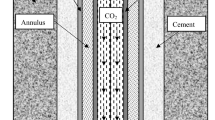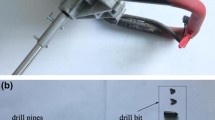Abstract
With the increase in mining depth of coal resources, high-temperature thermal damage has become increasingly prominent, and research on geotemperature in mining areas has received increasing attention. At present, simple temperature measurement is the most commonly used well temperature measurement method, but the obtained data cannot be used directly and need to be corrected. According to the thermal recovery law of an approximately steady-state hole, the “three-point” method is often used to correct simple well temperature data. However, the calibration work is complicated, time-consuming and laborious. Moreover, in the “three-point” method, the well depth and the time from when the well fluid stopping circulation to the temperature measurement (TSC) are not considered enough, which easily leads to deviations in the well temperature correction results. Based on the TSC and well depth, a simple well temperature correction equation was obtained by using 50 available data points with TSCs less than 20 h of approximate steady-state temperature measurements collected in the Huainan coalfield (TSC < 20 h in the general simple temperature measurements). The fitting effect of the equation was verified with the original ground temperature and geothermal gradient; in its application to the Huainan coalfield geothermal field, the model has achieved an ideal effect.





Similar content being viewed by others
References
Guo, P. Y. (2009). Characteristics of Geothermal field of deep mine and its heat damage Control in China. Dissertation, China Universiyu of Mining and Technology. ((in Chinese)).
Harrison, W.E., Luza, K.V., Prater, M.L., Chueng, P.K., Ruscetta, C.A. (1983). Geothermal resource assessment in Oklahoma. In Geothermal Energy Exploration and Resource Assessment Technical Conference. Salt Lake City, 01 July.
Hong, Y. M. (1993). Logging principle and comprehensive interpretation. Qingdao: China University of Petroleum Press. ((in Chinese)).
Ju, Y. W., Wei, M. M., & Xue, C. D. (2011). Control of basin-mountain evolution on the occurrence of deep coal and coalbed methane in North China. Journal of China University of Mining & Technology, 40(3), 390–398. ((in Chinese)).
Kehle, R. O., Schoeppel, R. J., & Deford, R. K. (1970). The AAPG geothermal survey of North America. Proceedings of the United Nations Symposium on the Development and Utilization of Geothermal Resources, 2, 358–367.
Luo, Y., Ju, Y. W., & Tan, J. Q. (2011). Characteristics of present geothermal field and prediction of its thermal damage in Suntuan-Zhaoji exploration area. Journal of Graduate University of Chinese Academy of Sciences, 28(6), 734–739. ((in Chinese)).
Mohammadreza, Z. R., Kamali, M. R., Mohammadnia, M., & Shabani, F. (2015). Estimation of true formation temperature from well logs for basin modeling in Persian Gulf. Journal of Petroleum Science and Engineering, 125(2015), 13–22.
Moore, T. A., Bowe, M., & Nas, C. (2014). High heat flow effects on a coalbed methane reservoir, East Kalimantan (Borneo), Indonesia. International Journal of Coal Geology, 131, 7–31.
Peng, T., Sun, J. F., Liu, K. X., Wu, J. W. (2018). Analysis of the characteristics of current geothermal field and geothermal bearing in Huainan coalfield. Journal of Anhui University of Science and Technology (Natural Science), 38(2), 16–21. ((in Chinese)).
Peng, T., Wu, J. W., Ren, Z. Q., Xu, S. P., & Zhang, H. C. (2015a). Distribution of terrestrial heat flow and structural control in Huainan-Huaibei Coalfield. Chinese J. Geophys., 58(7), 2391–2401. ((in Chinese)).
Peng, T., Wu, J. W., Ren, Z. Q., Xu, S. P., & Zhang, H. C. (2015b). Distribution Characteristics of Current Geothermal Field and Terrestrial Heat Flow in Huaibei Coalfield. Earth Science-Journal of China University of Geosciences, 40(6), 1083–1092. ((in Chinese)).
Rafael, R. D., & María, B. D. A. (2014). Estimating Limits for the Geothermal Energy Potential of Abandoned Underground Coal Mines, a Simple Methodology. Energies, 7, 4241–4260.
Ren, Z. Q., Peng, T., Shen, S. H., Zhang, H. C., Xu, S. P., & Wu, J. W. (2015). The Distribution Characteristics of Current Geothermal Field in Huainan Coalfield. Geological Journal of China University, 21(1), 147–154. ((in Chinese)).
Tan, J. Q., Ju, Y. W., Hou, Q. L., Zhang, W. Y., & Tan, Y. J. (2009). Distribution Characteristics and influence Factors of Present Geo-Temperature Field in Su-Lin Mine Area Huaibei Coalfield. Chinese J. Geophysics, 52(3), 732–739. ((in Chinese)).
Wang, G. L., Cao, D. Y., Jiang, B., Xu Z. B., Liu D. Y., Yan, S. Y. (1992). Thrust Nappe, Extension Gliding Nappe and Gravity Gliding Structure in the South of Northern China. China University of Mining & Technology Press, Xuzhou, 5–14. ((in Chinese)).
Wang, H. Y., Liu, S. W., & Lei, X. (2013). Present geothermal regime of the Lower Yangtze area, South China. Journal of China Coal Society, 38(5), 896–900. ((in Chinese)).
Waples, D. W., Pacheco, J., & Vera, A. (2004). A method for correcting log-derived temperatures in deep wells, calibrated in the Gulf of Mexico. Petroleum Geoscience, 10, 239–245.
Waples, D. W., & Pedersen, M. R. (2004). Evaluation of horner plot-corrected log-derived temperatures in the Danish Central Graben, North Sea. Natural Resources Research, 13, 223–227.
Waples, D. W., & Ramly, M. (2001). A statistical method for correcting log-derived temperatures. Petroleum Geoscience, 7, 231–240.
Wu, J. W., Wang, G. T., Zhai, X. R., Zhang, W. Y., Peng, T., & Bi, X. S. (2019). Geothermal geological characteristics and geothermal resources e-valuation of Huainan mining area. Journal of China Coal Society, 44(8), 2566–2578. ((in Chinese)).
Xu, S. P., Peng, T., & Ren, Z. Q. (2014). The calibration of drilling’s simple temperature measurement and analysis of difference at each field in Huainan mining area. Coal Technology, 33(6), 64–66. ((in Chinese)).
Yu, H. C. (1991). Mine geothermal and heat damage control. Coal Industry Press, Beijing, pp 35–41. ((in Chinese)).
Zhang, H., Zheng, Y. Z., Zheng, G. S., & Wang, S. Z. (2003). Extensional structure under the Fufeng-nappe in Huainan Coalfield, Anhui Province, and its formative mechanism. Coal Geology & Exploration, 31(3), 1–4. ((in Chinese)).
Zhong, S. X. (1985). Discussion on simple question about the temperature curve correction. Coal Geology and Exploration, 13(4), 48–51. ((in Chinese)).
Acknowledgments
This study was funded by the National Natural Science Foundation of China (41773100), the Teaching Research Project of School (szxy2017jy10), the Research Project of Wanbei Coal-Electricity Group Co. Ltd. (2020), the Project for Research Activities of Academic and Technological Leaders of Anhui Province (2020D239) and the Research Project of Huaibei Mining Group Co. (2020). The authors would like to thank the National Engineering Research Center of Coal Mine Water Hazard Controlling (Suzhou University). Thanks to Wanbei Coal-Electricity Group Co. Ltd., Huaibei Mining Group Co., Huainan Mining Co., Anhui University of Science and Technology, and Xi′an University of Science and Technology for providing convenient data collection conditions.
Author information
Authors and Affiliations
Corresponding authors
Rights and permissions
About this article
Cite this article
Guo, Y., Wei, J., Gui, H. et al. A Well Temperature Correction Based on the Least Squares Method and its Application in a Coal Mining Area, China. Nat Resour Res 30, 2287–2296 (2021). https://doi.org/10.1007/s11053-021-09843-3
Received:
Accepted:
Published:
Issue Date:
DOI: https://doi.org/10.1007/s11053-021-09843-3




